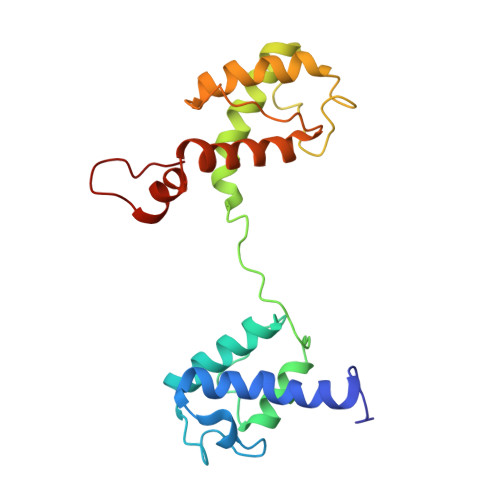Solution Structure and Conformational Dynamics of a Doublet Acyl Carrier Protein from Prodigiosin Biosynthesis.
Thongkawphueak, T., Winter, A.J., Williams, C., Maple, H.J., Soontaranon, S., Kaewhan, C., Campopiano, D.J., Crump, M.P., Wattana-Amorn, P.(2021) Biochemistry
- PubMed: 33416314
- DOI: https://doi.org/10.1021/acs.biochem.0c00830
- Primary Citation of Related Structures:
5Y08 - PubMed Abstract:
The acyl carrier protein (ACP) is an indispensable component of both fatty acid and polyketide synthases and is primarily responsible for delivering acyl intermediates to enzymatic partners. At present, increasing numbers of multidomain ACPs have been discovered with roles in molecular recognition of trans-acting enzymatic partners as well as increasing metabolic flux. Further structural information is required to provide insight into their function, yet to date, the only high-resolution structure of this class to be determined is that of the doublet ACP (two continuous ACP domains) from mupirocin synthase. Here we report the solution nuclear magnetic resonance (NMR) structure of the doublet ACP domains from PigH (PigH ACP 1 -ACP 2 ), which is an enzyme that catalyzes the formation of the bipyrrolic intermediate of prodigiosin, a potent anticancer compound with a variety of biological activities. The PigH ACP 1 -ACP 2 structure shows each ACP domain consists of three conserved helices connected by a linker that is partially restricted by interactions with the ACP 1 domain. Analysis of the holo (4'-phosphopantetheine, 4'-PP) form of PigH ACP 1 -ACP 2 by NMR revealed conformational exchange found predominantly in the ACP 2 domain reflecting the inherent plasticity of this ACP. Furthermore, ensemble models obtained from SAXS data reveal two distinct conformers, bent and extended, of both apo (unmodified) and holo PigH ACP 1 -ACP 2 mediated by the central linker. The bent conformer appears to be a result of linker-ACP 1 interactions detected by NMR and might be important for intradomain communication during the biosynthesis. These results provide new insights into the behavior of the interdomain linker of multiple ACP domains that may modulate protein-protein interactions. This is likely to become an increasingly important consideration for metabolic engineering in prodigiosin and other related biosynthetic pathways.
- Department of Chemistry, Special Research Unit for Advanced Magnetic Resonance and Center of Excellence for Innovation in Chemistry, Faculty of Science, Kasetsart University, Bangkok 10900, Thailand.
Organizational Affiliation:
















